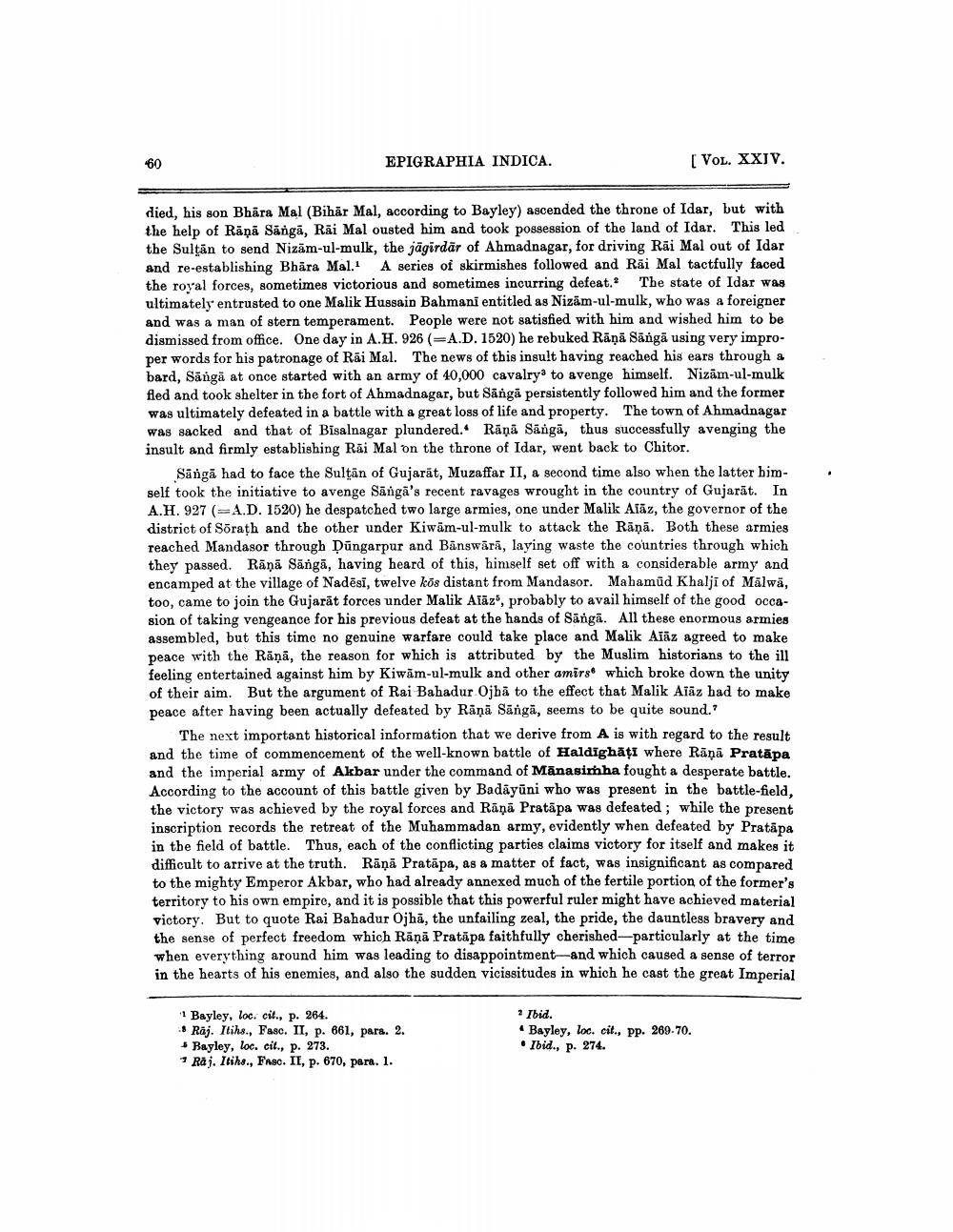________________
EPIGRAPHIA INDICA.
[Vol. XXIV.
died, his son Bhāra Mal (Bihar Mal, according to Bayley) ascended the throne of Idar, but with the help of Räņā Sängā, Räi Mal ousted him and took possession of the land of Idar. This led the Sultan to send Nizam-ul-mulk, the jägirdär of Ahmadnagar, for driving Rai Mal out of Idar and re-establishing Bhära Mal. A series of skirmishes followed and Räi Mal tactfully faced the royal forces, sometimes victorious and sometimes incurring defeat. The state of Idar was ultimately entrusted to one Malik Hussain Bahmani entitled as Nizam-ul-mulk, who was a foreigner and was a man of stern temperament. People were not satisfied with him and wished him to be dismissed from office. One day in A.H. 926 (=A.D. 1520) he rebuked Rāņā Sāngā using very improper words for his patronage of Räi Mal. The news of this insult having reached his ears through a bard, Sāngā at once started with an army of 40,000 cavalry to avenge himself. Nizam-ul-mulk fled and took shelter in the fort of Ahmadnagar, but Sänga persistently followed him and the former was ultimately defeated in a battle with a great loss of life and property. The town of Ahmadnagar was sacked and that of Bisalnagar plundered. Rāņā Sāngā, thus successfully avenging the insult and firmly establishing Rai Mal on the throne of Idar, went back to Chitor.
Sāngā had to face the Sultan of Gujarat, Muzaffar II, a second time also when the latter bimself took the initiative to avenge Sänga's recent ravages wrought in the country of Gujarāt. In A.H. 927 (=A.D. 1520) he despatched two large armies, one under Malik Alāz, the governor of the district of Sõrath and the other under Kiwām-ul-mulk to attack the Rāņā. Both these armies reached Mandasor through Dungarpur and Bānswārā, laying waste the countries through which they passed. Rāņā Sāngā, having heard of this, himself set off with a considerable army and encamped at the village of Nadēsi, twelve kos distant from Mandasor. Mahamud Khalji of Mālwā, too, came to join the Gujarat forces under Malik Alāz", probably to avail himself of the good occasion of taking vengeance for his previous defeat at the hands of Sānga. All these enormous armies assembled, but this time no genuine warfare could take place and Malik Aiäz agreed to make peace with the Räņa, the reason for which is attributed by the Muslim historians to the ill feeling entertained against him by Kiwam-ul-mulk and other amirs which broke down the unity of their aim. But the argument of Rai Bahadur Ojhà to the effect that Malik Aiäz had to make peace after having been actually defeated by Rāņā Sāngā, seems to be quite sound.?
The next important historical information that we derive from A is with regard to the result and the time of commencement of the well-known battle of Haldighăți where Rāņā Pratāpa and the imperial army of Akbar under the command of Mānasimha fought a desperate battle. According to the account of this battle given by Badāyāni who was present in the battle-field, the victory was achieved by the royal forces and Rāņā Pratāpa was defeated; while the present inscription records the retreat of the Muhammadan army, evidently when defeated by Pratápa in the field of battle. Thus, each of the conflicting parties claims victory for itself and makes it difficult to arrive at the truth. Rāņā Pratāpa, as a matter of fact, was insignificant as compared to the mighty Emperor Akbar, who had already annexed much of the fertile portion of the former's territory to his own empire, and it is possible that this powerful ruler might have achieved material victory. But to quote Rai Bahadur Ojhā, the unfailing zeal, the pride, the dauntless bravery and the sense of perfect freedom which Rāņā Pratāpa faithfully cherished-particularly at the time when everything around him was leading to disappointment- and which caused a sense of terror in the hearts of his enemies, and also the sudden vicissitudes in which he cast the great Imperial
1 Bayley, loc. cit., p. 264. .: Raj. Itihs., Fasc. II, p. 661, para. 2. * Bayley, loc. cit., p. 273. - Raj. Itiha., Fasc. II, p. 670, para. 1.
? Ibid. • Bayley, loc. cit., pp. 269-70. • Ibid., p. 274.




